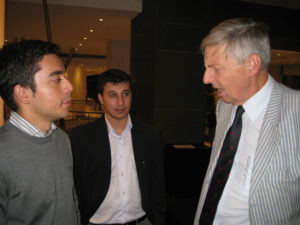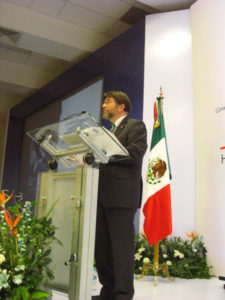POSTED ON Two posts below
The Northampton Study
The Northampton Study is a project we have been working on over the summer to gather the opinions of generation Y about leather. This study was used in part for a paper on consumer power in the leather industry given to the Centenary Conference of the Textile Institute in Manchester by Rachel Garwood and I earlier this month.
We struggled a bit to get enough responses during the summer but so far the results have been very consistent and we are comfortable to develop arguments from them.
First young people do like leather, but they see it mostly as a luxury or fashion item rather than the essential every day material that it was to their parents and grandparents. They are very well aware of issues related to raw material, to processing and environmental problems and to labour in developing countries. Not in detail of course but enough for awareness and concern. Yet few would allow these to stop them purchasing and a high percentage say that they trust the brands to manage these issues for them.
Consumers want to repair, not throw away
What these and other questions we asked do tell us is that there is a great need to undertake some consumer education to put the real facts out into the discussions which run through the press using pejorative anti leather and anti meat language. Be it about animal rights, toxic chemicals and sweatshop labour good science and education of designers, retailers and the public is needed. From the responses we have animal welfare is the strongest issue for the young, followed by labour issues in overseas factories. And in some material published by certain groups there is a definitive move to make young people believe that any idea of eating meat or using leather is a bad thing. Now we know that many vegetarians are actually happy to buy leather and even to design articles using it, but if these anti-leather views are allowed to insinuate themselves into the mind of the next big generation of shoppers leather will have a problem.
Another interesting point is that high up amongst the priorities of generation Y is a strong demand for articles of leather to be able to be repaired. It is hard to see how this squares with the throw away society that buys a Primark top for a single use at a party with a wish to repair a leather handbag but this view was a very clear outcome. The purchase of a quality leather handbag is seen as a long term investment. The consumers know that leather generally wears very well and can look good for many years. They want to be able to keep it longer and to have it repaired in order to do so. It is hard to actually think of a more positive statement that can be made about leather as a sustainable, quality, natural material.
Mike Redwood
18th November 2010
POSTED ON
Life after recession: party in Bologna

The leather industry is having a good time right now. The dip of the recession was shorter and less severe – apart from the auto trade – than we had feared and the bounce back – especially the auto trade – was better than we imagined.
We are getting to see a little bit of the future though. It is the better segments which are doing well and raw material prices are high. Expect more of this. Indeed this is the future.
Meanwhile the relentless march of trade shows and congresses continues. The SLTC had its one day conference near Sheffield. After a successful Shanghai everyone moved to Bologna which was also quite busy, and where the Corium Club had another super party with all the usual suspects and quite a few new ones.
Making Bologna Work

It was hard to work out how to fit a Corium club event in at Bologna with everyone exiting the show area in the early evening and many staying in hotels in Florence and other outlying towns. Yet the venue by the station and the early evening timing works well and now we can look forward to this as a regular event. Like the Hong Kong APLF party the Bologna TanningTech/Lineapelle event has now become a new tradition.
At the same time other events were taking place. Calzatecnia and UITIC are organisations that are not widely known in the tanning industry. Calzatecnia is the organisation for Mexican shoemakers and with Mexico being one of the world’s top ten shoemaking countries it is an important body. UITIC is a body for shoe technicians which has member throughout the world. So this year for the first time they held a combined conference in Mexico which was organised by CIATEC which is dynamic and well directed body that services the Mexican shoe and leather businesses.
It is not often that the industry runs congresses that have over 500 people in the audience but this one reached 600 at its peak, which is a record for Calzatecnia, and the press were around writing prominent articles. Leather and footwear is a serious business in Mexico. The conference was themed on innovation, which is itself not too innovative, although one up on sustainability which has become the standard theme these days. Yet it was put into practise in an entertaining way as the conference looked at fashion trends, aspects of marketing, robotics and nanotechnology. There was a fascinating talk on how some Japanese manufacturing methods have been successfully introduced to the large Flexi shoemaking group. So this was far from an endless series of lectures on “thinking out of the box” and ensuring that the new innovative culture “includes the people at the very top”.
It is great that Flexi has an alumnus running its marketing. It is an exceptional company to have grown out of the benign protected Mexican market. Protection has made life too easy, and has allowed the domestic makers to move along only marginally troubled by international competition if the Mexican market place is opened to competition many companies will suffer. Flexi is one of those that should be able to withstand any onslaught and what is more is itself moving as a brand into the international market. This is important since places like Portugal, Brazil and even little Morocco should have many famous international brands by now and will need to do something about it soon.
The tanning industry has in some part at least hitched its wagon to the automobile upholstery trade and gone in a different direction. We visited some fine wet blue and full hide tanneries, as well as one making large quantities of vegetable tanned sole leather. It is an exciting sight to see so much of this traditional leather being tanned in the 21st century.
Mike Redwood
1st November, 2010